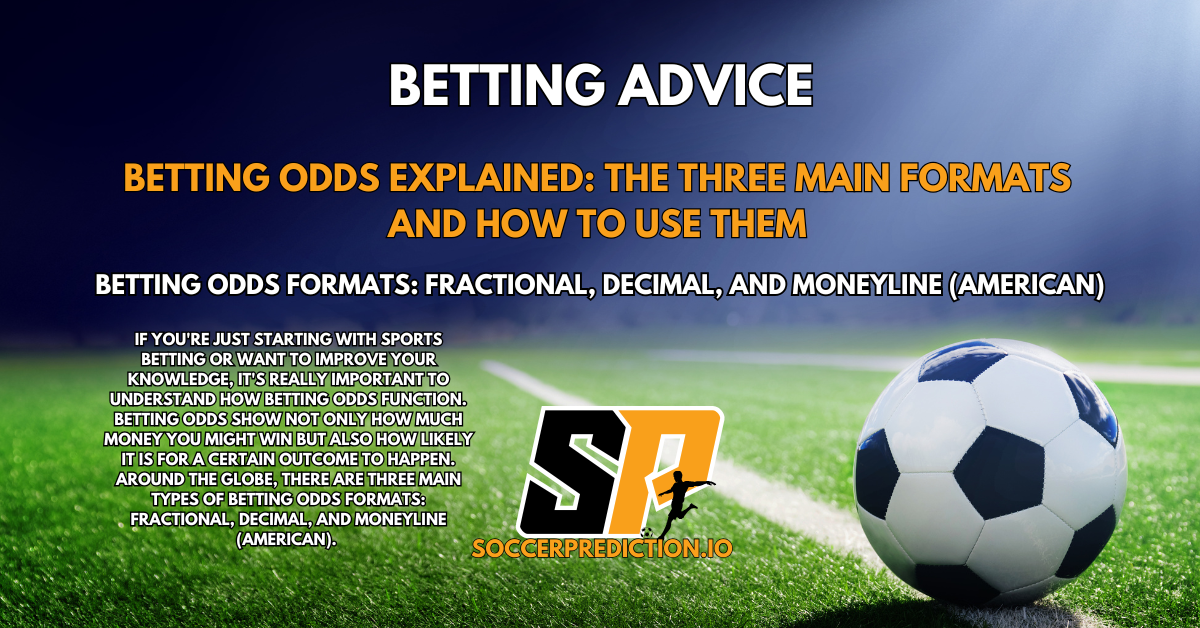Mathematical Models and Formulas for Soccer Betting
Introduction: Soccer betting can be approached scientifically by using mathematical formulas and models to predict match outcomes and identify profitable value bets. This guide provides a comprehensive overview of key quantitative concepts in soccer betting. We will cover fundamental betting metrics (like expected value and ROI), probabilistic models for match prediction (Poisson goal models, Elo ratings, machine learning, Bayesian inference), techniques for spotting value bets, and additional factors such as home advantage, team strength modeling, and avoiding overfitting. Throughout, we include formulas, examples, and tables to illustrate how these tools can improve betting outcomes.

Table of Contents
1. Fundamental Betting Metrics
Successful betting starts with understanding core metrics that quantify the attractiveness of a bet and the performance of a betting strategy. Key metrics include Expected Value (EV) of a bet, Return on Investment (ROI) over time, the Kelly Criterion for stake sizing, and converting betting odds to implied probability. These metrics help bettors evaluate whether a wager is +EV (positive expected value) and manage their bankroll efficiently.
1.1 Expected Value (EV)
Expected value represents the average outcome a bettor can expect from a bet if the same wager were repeated many times. In betting, EV is the long-term average profit or loss per bet, taking into account the probability of winning and losing. The formula for a bet’s expected value is:
EV=(Probability of Win)×(Profit if Win) − (Probability of Loss)×(Stake) .EV=(Probability of Win)×(Profit if Win)−(Probability of Loss)×(Stake).
In words, you multiply the chance of winning by the profit gained on a win, then subtract the chance of losing times the stake (which is the amount lost if the bet fails). If a bet can end in multiple outcomes with different payouts, the EV is the probability-weighted sum of all outcome values.
Interpreting EV: A positive EV (+EV) means you expect to profit over the long run by taking that bet (it’s a “value bet”), while a negative EV (–EV) means you would expect to lose money on average. A fair bet with true odds will have EV = 0 (break-even in the long run). Skilled bettors aim to only place bets that have +EV, as this implies an edge over the sportsbook.
Example – Coin Toss: Consider a fair coin toss (50% win probability for heads). At fair odds, the payout for a $10 bet might be $20 (including your $10 stake) for a win, which gives zero EV: 0.5×$10 profit−0.5×$10 loss=$00.5×$10 profit−0.5×$10 loss=$0. Now suppose a bookmaker offers odds 2.15 (decimal) for heads instead of 2.0. That means a $10 stake returns $21.50 (profit $11.50) on heads. The EV becomes 0.5×$11.50−0.5×$10=$0.750.5×$11.50−0.5×$10=$0.75. This is +$0.75 per $10 bet, or +7.5% of the stake, indicating a +EV bet. Taking such a wager repeatedly would theoretically yield profit over time.
Example – Soccer Match: Suppose your model estimates Team A has a 40% chance to win an upcoming match. A sportsbook is offering odds 3.00 on Team A (implying only ~33.3% chance, see Section 1.4). If you bet $100, your profit if Team A wins would be $200 (since 3.00 decimal odds mean $100 → $300 return, which is $200 profit). The expected value is 0.40×$200−0.60×$100=$80−$60=$200.40×$200−0.60×$100=$80−$60=$20. This EV is positive (+$20), suggesting a value bet. In contrast, if the odds were only 2.50 (implied 40%), the EV would be zero, and if odds were 2.20 (implied ~45.5%), EV would be negative (bad bet) given your 40% win probability.
Positive EV bets do not guarantee a win every time (outcomes are still uncertain), but over many bets a positive EV strategy should yield profits. Identifying +EV opportunities is thus fundamental to profitable betting.
1.2 Return on Investment (ROI)
Return on Investment (ROI) measures the efficiency of your betting strategy by comparing your net profit to the total amount wagered (or to your bankroll). ROI is typically expressed as a percentage and indicates how much your investment in bets has grown (or shrunk) over a period of time.
ROI Formula: ROI=Net ProfitTotal Amount Staked×100% .ROI=Total Amount StakedNet Profit×100%. This is a simple ratio: profit earned divided by money invested in bets. For example, if you placed a series of bets totaling $1,000 and ended up with a net profit of $200, your ROI is $200/$1000 = 20%. ROI can be calculated over any time frame or number of bets (e.g. weekly, monthly, or per season).
Interpreting ROI: A positive ROI means your betting strategy is profitable (you’re getting a positive return on the money put at risk), whereas a negative ROI means losses on your investment. Professionals may achieve an ROI of only a few percent (e.g. +5%), but over large volumes of money or bets this is significant. Consistent ROI in the range of 3–6% is often considered strong for sports betting. ROI is useful for comparing strategies or bettors on an equal footing, since it accounts for the scale of bets.
Yield vs ROI: In betting discussions, yield is a related metric usually defined similarly to ROI – as net profit divided by total stakes. Some sources distinguish ROI as profit relative to an initial bankroll, whereas yield is profit relative to total turnover. For our purposes, ROI as defined above (profit/total staked) is a key indicator of performance. For instance, if you started with a $3,000 bankroll and ended the year with $3,900 (a $900 profit from betting) after staking a total of $20,000 across all bets, your overall ROI would be 900/20000 = 4.5% yield, and your bankroll grew by 30%.
ROI helps determine if a betting method truly works. A high win rate alone can be misleading if odds are low; ROI captures the balance of odds and wins. In summary, track ROI to evaluate long-term betting success, aiming for a positive and sustainable percentage.
1.3 Kelly Criterion (Optimal Bet Sizing)
The Kelly Criterion is a formula that helps determine the optimal fraction of your bankroll to stake on a bet in order to maximize long-term growth. Unlike EV (which tells you if a bet is worth taking), Kelly tells you how much to bet when you have an edge. Kelly’s formula finds the stake size that maximizes the expected logarithmic growth of wealth, essentially balancing risk and reward.
For a bet with a known probability p of winning (implying probability q = 1-p of losing) and decimal odds O (which yield a net profit b = O – 1 per unit staked if you win), the Kelly fraction f (fraction of bankroll to wager) is:
f∗ = p − qb = p×O−1O−1 .f∗=p−bq=O−1p×O−1.
This formula can be read as: bet a fraction of your bankroll equal to your edge (p minus the “implied loss probability” weighted by the payout factor). For example, if you estimate a 60% chance of winning (p = 0.6) on an even-money bet (decimal odds O = 2.0, so b = 1 net profit per $1 bet), Kelly suggests f = 0.6 – 0.4/1 = 0.2, i.e. 20% of your bankroll on that bet. A higher edge or bigger payout increases the suggested stake, whereas a very small edge yields a tiny fraction.
Key points about Kelly:
Kelly staking maximizes the theoretical growth rate of your bankroll in the long run. If you consistently bet fractions per Kelly, your bankroll is expected to grow faster than with any flat or smaller stakes strategy, under ideal conditions.
However, full Kelly bets can be aggressive and lead to high volatility. In practice, many bettors use a fraction of the Kelly stake (e.g. half-Kelly or quarter-Kelly) to reduce risk of large drawdowns, since estimation errors in p can cause over-betting. A full Kelly strategy, while maximizing growth, can result in large swings; a fractional Kelly gives up some growth for smoother results.
Kelly criterion assumes you know your true probability p. If your estimated p is wrong, the Kelly bet might be too high. Thus, use Kelly with caution and consider your confidence in the edge.
In summary, the Kelly criterion is a valuable money-management tool for value bettors: it tells you how to scale your bets according to the size of your advantage. A positive EV bet should theoretically get a positive Kelly fraction (bet something), while a negative EV bet yields a negative or zero Kelly suggestion (don’t bet). By betting proportional to your edge, Kelly staking can optimize growth and avoid ruin (it will never suggest betting more than your bankroll, and it downscales bets when the edge is small).
1.4 Odds Conversion and Implied Probability
Betting odds come in different formats (decimal, fractional, American), but they all represent the implied probability of an outcome, after accounting for bookmaker margin. Being able to convert odds to probability (and vice versa) is crucial for comparing bets and identifying value.
Decimal Odds: In decimal format (popular in Europe and for online betting), the odds number O directly tells you the total return for a $1 stake. The implied probability (before accounting for bookmaker margin) is simply 1/O. For example, decimal odds 2.00 imply a 50% chance (1/2.00 = 0.50), odds 3.00 imply ~33.3% (1/3.00), odds 1.50 imply ~66.7%, and so on. You can convert an implied probability P (in percent) to decimal odds by O = 100 / P%.
Fractional Odds: Fractional odds (e.g. “5/2” or “2/5”) quote the net profit relative to the stake. For instance, 5/2 means you win $5 profit for every $2 staked. To convert fractional to decimal, add 1: decimal = (numerator/denominator) + 1. A 5/2 odds is 2.5 + 1 = 3.5 in decimal, implying ~28.6% probability (1/3.5). Likewise, a favorite at 1/4 (bet $4 to profit $1) is decimal 1.25, implying 80%. The general formula for implied probability from fractional A/B is B/(A+B).
American Odds: These are given as a positive or negative number. Positive +X means you win X profit on $100 stake; negative –Y means you must stake Y to win $100 profit. To convert to decimal: for +X, decimal = (X/100) + 1; for –Y, decimal = (100/Y) + 1. Then convert decimal to probability as above. For example, +200 in American is decimal 3.00 (imply ~33.3%), and -200 is decimal 1.50 (imply ~66.7%).
Bookmaker Margin: Note that when you sum the implied probabilities of all outcomes in a market (home, draw, away), they exceed 100% – this overround is the bookmaker’s edge. You might calculate implied probabilities from market odds and see, for example, 105% total instead of 100%. To get the “true” probabilities, one often normalizes by that total or subtracts margin, but the key is understanding odds inherently include a margin.
Example – Odds to Probability: Consider an English Premier League match with odds from a bookmaker (in decimal):
| Outcome | Odds (Decimal) | Implied Probability (%) |
|---|---|---|
| Arsenal to Win | 2.76 | 36.23% |
| Draw | 3.40 | 29.41% |
| Manchester Utd to Win | 2.78 | 35.97% |
These odds imply Arsenal has about a 36.2% chance, draw 29.4%, and Man U 36.0%. The probabilities sum to ~101.6%, indicating a ~1.6% built-in margin (typical if the bookmaker uses a 2% commission or vig in the prices). As a value bettor, you would compare these implied probabilities to your own estimated probabilities. For instance, if you believe Manchester United actually has a 40% chance in this match, you see that the book’s odds (35.97% implied) underestimates them – a potential value bet (see Section 3).
Understanding odds conversion lets you quickly assess whether your predicted probability for an outcome is higher or lower than the market’s implied probability. This comparison is the crux of finding value bets.
(Tip: Always convert odds to implied probability before judging a bet’s value. Odds can be deceptive in raw form, especially across different formats, but probabilities put everything on a common scale of 0–100%.)









